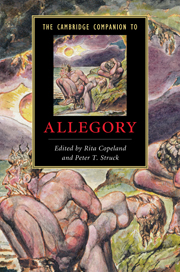Book contents
- Frontmatter
- Introduction
- Part I: Ancient foundations
- Part II: Philosophy, theology, and poetry 200 to 1200
- Part III: Literary allegory: philosophy and figuration
- 8 Allegory in the Roman de la Rose
- 9 Dante and allegory
- 10 Medieval secular allegory: French and English
- 11 Medieval religious allegory: French and English
- 12 Renaissance allegory from Petrarch to Spenser
- 13 Protestant allegory
- 14 Allegorical drama
- Part IV: The fall and rise of allegory
- Further reading
- Index
11 - Medieval religious allegory: French and English
from Part III: - Literary allegory: philosophy and figuration
Published online by Cambridge University Press: 28 January 2011
- Frontmatter
- Introduction
- Part I: Ancient foundations
- Part II: Philosophy, theology, and poetry 200 to 1200
- Part III: Literary allegory: philosophy and figuration
- 8 Allegory in the Roman de la Rose
- 9 Dante and allegory
- 10 Medieval secular allegory: French and English
- 11 Medieval religious allegory: French and English
- 12 Renaissance allegory from Petrarch to Spenser
- 13 Protestant allegory
- 14 Allegorical drama
- Part IV: The fall and rise of allegory
- Further reading
- Index
Summary
In the second recension of Guillaume de Deguileville's Pelerinage de la vie humaine (translated by John Lydgate) the narrator cannot understand his allegorical pilgrim's bag of faith and staff of good hope until Grace Dieu tells him that she will “Bothe thyn Eyen take awey . . . And in thyn Erys I shal hem sette.” This surprising course of action is an allusion to St. Paul's statement that “faith comes by hearing”: the physical senses may be unreliable, but for Paul and Deguileville hearing connotes both a literal and a figural “hearing” of the “word” of God - and the imaginative, internal “seeing” this brings. After an extended explanation by Grace Dieu, the narrator tells us, “Myn eyen two she gan translate / Into myn Eryn, ther they stood.” This bizarre sequence involves several mutually commenting discourses; its narrative is “glossed” by the doctrinal proposition that “faith comes from hearing,” but the doctrinal proposition is also “glossed” by the strange and unnatural images and narrative - faith is counter-intuitive and contrary to the order of nature. Further allegorical commentary is provided by the informed words of Grace Dieu and the uninformed words of the narrator, while the rest of the narrative tells us about the position from which they speak: such allegorical speakers represent and reify within the narrative the very business of interpretation.
- Type
- Chapter
- Information
- The Cambridge Companion to Allegory , pp. 148 - 161Publisher: Cambridge University PressPrint publication year: 2010
- 2
- Cited by



